Antenna Extension Cable Guide: Types, Length & Loss
Sep 07,2025
Introduction
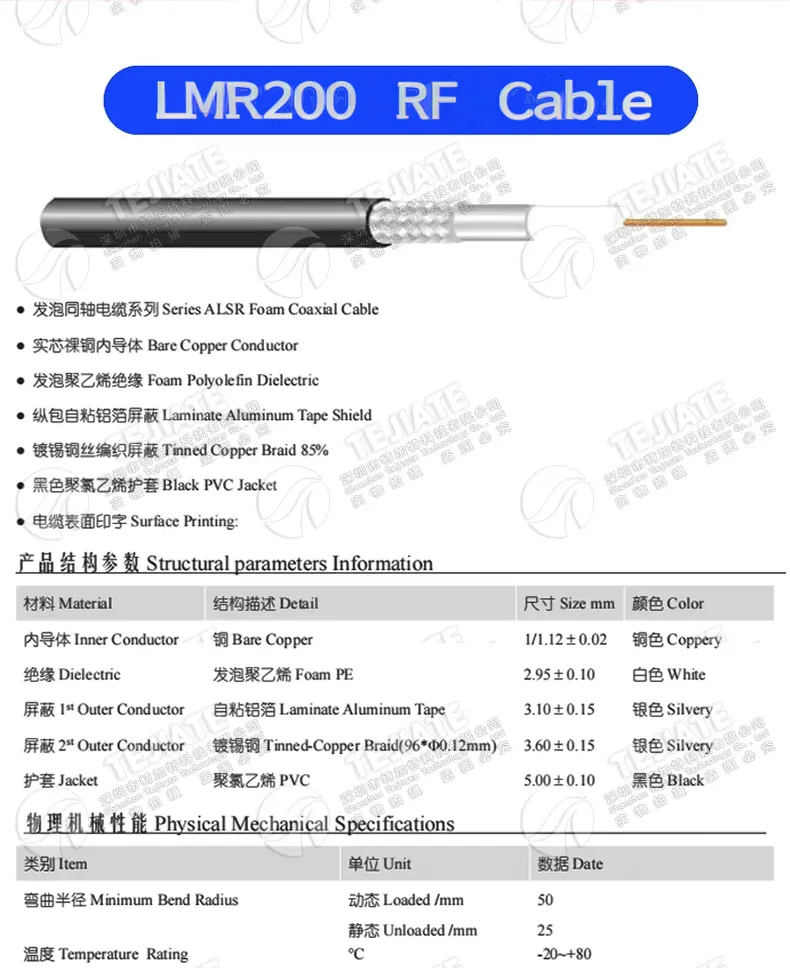
This image is a technical illustration or high-resolution macro photograph that visually breaks down the components listed in the "Structural parameters" table. It likely shows a cross-section of the cable, clearly displaying: 1) The central Bare Copper Conductor (1.12mm). 2) The white Foam Polyolefin Dielectric insulation layer. 3) The Laminate Aluminum Tape Shield wrapped around the dielectric. 4) The Tinned Copper Braid (85% coverage) over the tape shield. 5) The outer Black PVC Jacket. This image is crucial for engineers and installers to understand the build quality and the materials responsible for the cable's electrical performance (impedance, loss) and mechanical properties (flexibility, durability).
When your Wi-Fi cuts out during a call or your GPS suddenly drifts off course, the antenna itself isn’t always to blame. More often, the weak link is the cable connecting the antenna to the device. Adding an antenna extension cable gives you the freedom to place the antenna where it works best—higher on a wall, above a cabinet, or even outdoors. That extra height can dramatically improve line of sight (LoS) and reduce the multipath reflections that plague indoor signals.
Of course, nothing in RF is free. Every coax introduces loss. A slim option like RG174, just 2.85 mm in diameter, can drop about 1.5 dB per meter at 2.4 GHz and closer to 2.5 dB at 5.8 GHz. Stretch it to 3 m, and you’ve already given up a significant share of usable power. By comparison, LMR200 holds losses to roughly 0.5 dB/m, while LMR240 trims it further to just 0.25 dB/m at 2.4 GHz. In practice, that difference can decide whether a 10 m run is still usable or not.
So the real question—one debated endlessly on forums like Amateur Radio Stack Exchange—is this: Is it better to raise the antenna with an extension, or keep the cable short? From experience, the answer depends on your environment. If moving the antenna clears a concrete wall or metal cabinet, the height gain often outweighs the extra 1–2 dB lost in coax. The trick is knowing where that balance lies for your setup.
What Is an Antenna Extension Cable?
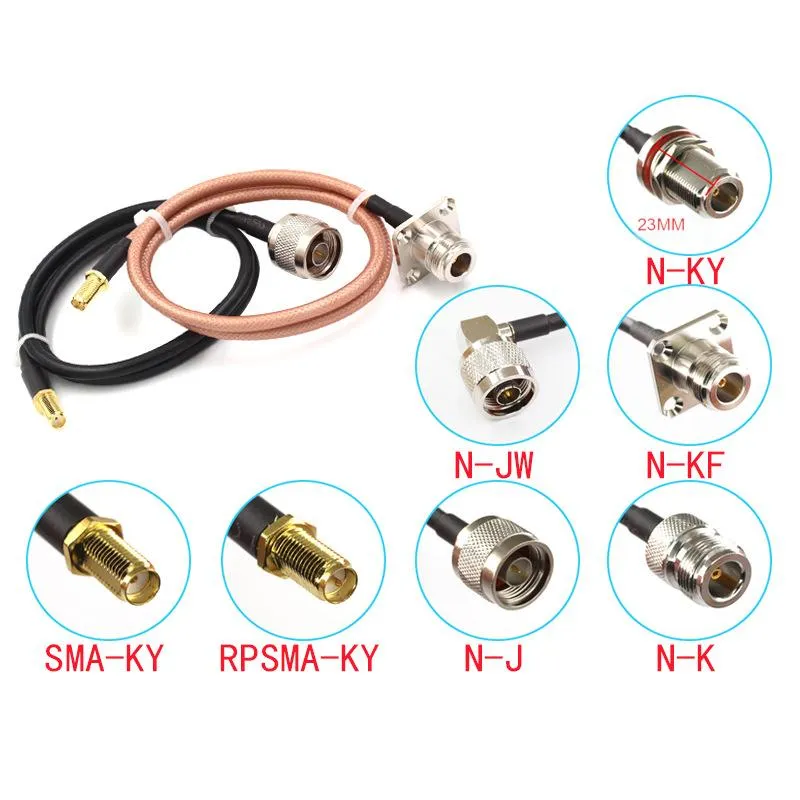
This image depicts the core concept introduced in the guide's introduction. It likely shows a common problem scenario: a Wi-Fi router placed inside a cabinet or behind an object, with poor signal strength. The solution is shown alongside or in a "after" shot: an antenna extension cable (likely with RP-SMA connectors for a router) connecting the router's port to its antenna, which is now positioned on top of the cabinet or on a high shelf, unobstructed and in a clearer line of sight (LoS). This visualizes the fundamental trade-off and value proposition discussed: sacrificing a small amount of signal strength (cable loss) for a much greater gain in antenna positioning.
An antenna extension cable isn’t some kind of signal converter—it doesn’t turn Wi-Fi into Ethernet or magically boost power. Instead, it’s a straightforward coaxial assembly designed to move your antenna to a better location. Think of it as an extension cord for RF signals: simple in concept, but crucial in practice.
The structure is typically two parts:
- Coaxial cable — options like RG174, LMR200, or LMR240, each with its own balance of flexibility, thickness, and signal loss per meter.
- Connectors — usually SMA, RP-SMA, or N-type, selected to match the device and antenna interface.
It’s also important to distinguish between a pigtail and a true extension. A pigtail is short—maybe 10–30 cm—often found inside routers, linking a U.FL port on the board to an external jack. By contrast, an extension cable can run several meters, letting you relocate an antenna across a room, through an enclosure, or even onto a rooftop.
People often ask: Can a router antenna cable double as an extension? Technically, yes—if the connectors fit and the coax is up to the task. But here’s the catch: running a router antenna cable made of RG174 beyond 3 m usually kills more signal than it saves. That’s why many installers switch to LMR200 or LMR240 when length starts to matter. It’s one of those small choices that separates a working setup from a frustrating one.
Connector Options
Choosing the right connector is just as critical as picking the right coax. A small mismatch here can mean the antenna won’t connect at all, or worse, you end up damaging the threads. Many beginners confuse SMA with RP-SMA, and the difference is easy to miss until the parts don’t fit.
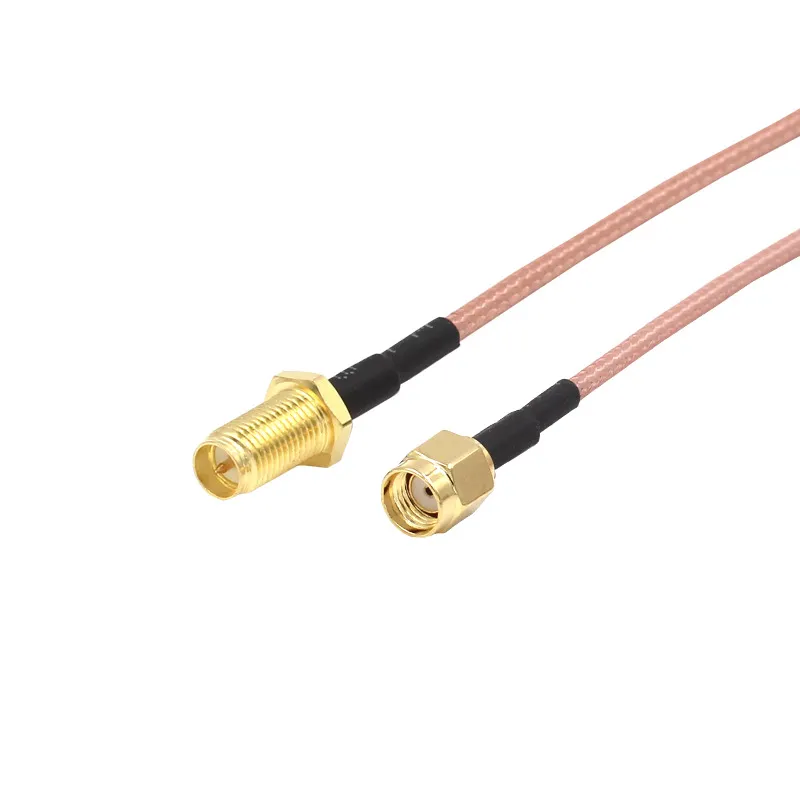
This image provides a clear product view of one of the most common antenna extension cable types mentioned: the SMA male to female extension cable. It clearly shows the two ends: the SMA male plug with its characteristic center pin and external threads, and the SMA female jack with its center socket (receptacle) and internal threads. This type of cable is explicitly noted for its use in applications like GPS modules and IoT gateways, and for its role as a feed-through solution in enclosures ("pass through an enclosure wall"). The image helps users correctly identify this specific connector combination.
- SMA connectors are widely used in GPS modules, IoT gateways, and RF test gear. A common build is an sma male to female extension cable, which makes it easier to pass through an enclosure wall without re-terminating the coax.
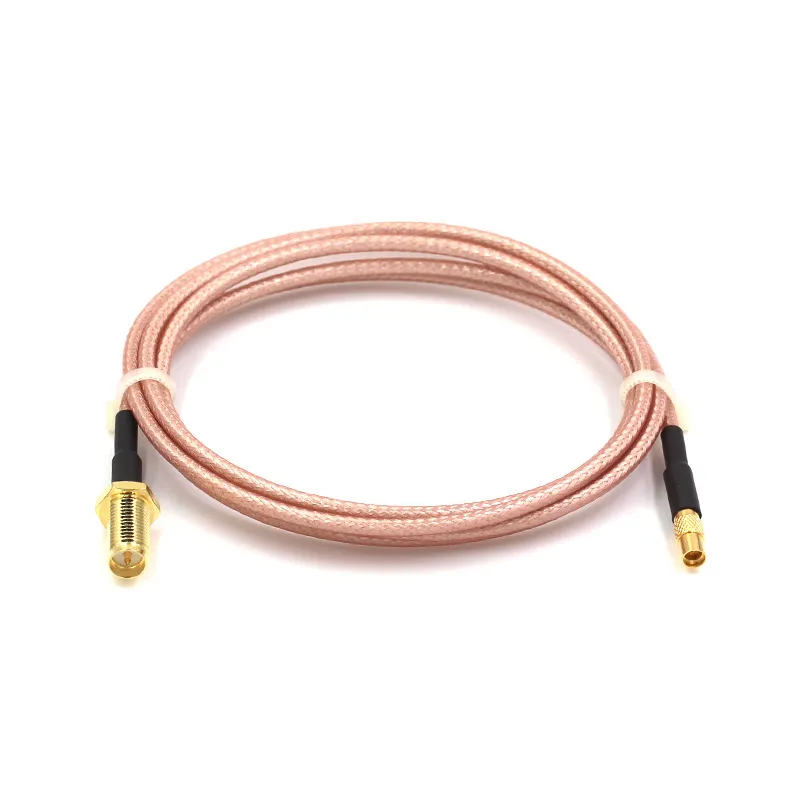
This image focuses on the RP-SMA connector ecosystem, which is stated as the "default on most Wi-Fi routers and access points." It likely depicts the end of an RP-SMA extension cable (the male end, which has a socket instead of a pin) screwing onto or connected to the female RP-SMA port on a Wi-Fi router. This visually reinforces the critical compatibility point: routers use RP-SMA, so you need an RP-SMA antenna extension cable (e.g., RP-SMA male to RP-SMA female) to extend them, not a standard SMA cable. This distinction is crucial to avoid connection errors and damage.
- RP-SMA connectors are the default on most Wi-Fi routers and access points. The “reverse polarity” design flips the pin and socket arrangement: an rp-sma male has a socket instead of a pin. This is why an rp-sma extension cable (often sold as an rp-sma antenna extension cable) is the go-to option when extending router antennas.

This image showcases the cable assembly recommended for demanding outdoor applications, particularly for 4G/5G/LTE installations. It features a thicker, low-loss cable like LMR240, terminated on one end with a large, rugged, weather-sealed N-type male connector (for the outdoor antenna side) and on the other end with a standard SMA female connector (for the indoor modem or gateway side). This exemplifies the solution described in the text: "n male to sma female extension is the standard way to connect a rooftop LTE or 5G antenna to indoor equipment." The image emphasizes the robustness required for outdoor durability and low-loss performance over longer distances
- N-type connectors are larger, rugged, and built for outdoor work. They seal better against moisture and handle torque without stripping. Paired with low-loss coax like LMR240, an n male to sma female extension is the standard way to connect a rooftop LTE or 5G antenna to indoor equipment.
To avoid mistakes, here are three quick checks that seasoned installers swear by:
- Is it SMA or RP-SMA? They’re not interchangeable, so forcing them can ruin the port.
- Which connector will be outdoors? N-type is usually the safer bet thanks to its weatherproofing.
- Not sure about gender? Look at the center: if the male has a socket, it’s RP-SMA; if it has a pin, it’s standard SMA.
These details may feel trivial, but skipping them is how people end up ordering the wrong cable. A simple pin check before purchase can save both money and frustration.
Cable Choices & Loss
Not all extension cables are created equal. The type of coax you select decides how much of your signal actually makes it to the antenna—and how flexible or rugged the cable will be once installed.
- RG174 is the classic lightweight option. With an outer diameter of just 2.85 mm, it’s easy to bend and route through tight spaces. Installers often use an rg174 extension cable for short GPS or Wi-Fi setups where space matters more than ultimate performance. The drawback is high attenuation: about 1.5 dB per meter at 2.4 GHz and around 2.5 dB per meter at 5.8 GHz. Over 3 m, the loss can become hard to ignore.
- LMR200 offers a middle ground. At 5.0 mm OD, it includes a foam PE dielectric and dual shielding (aluminum foil plus copper braid). That construction keeps loss to ~0.5 dB/m at 2.4 GHz and ~0.8 dB/m at 5.8 GHz. It’s a popular choice for mid-length Wi-Fi and IoT runs, where 3–5 m extensions are common.
- LMR240 is the go-to for low loss. Slightly thicker at 6.1 mm, it trims attenuation to ~0.25 dB/m at 2.4 GHz and ~0.4 dB/m at 5.8 GHz, making it ideal for outdoor LTE or 5G installations that need 10 m of coax without crippling the signal.
Here’s a quick comparison based on TEJTE’s data:
| Cable Type | OD (mm) | Loss @ 2.4 GHz (dB/m) | Loss @ 5.8 GHz (dB/m) | Best Fit |
|---|---|---|---|---|
| RG174 | 2.85 | ~1.5 | ~2.5 | Short GPS/Wi-Fi runs, tight spaces |
| LMR200 | 5.0 | ~0.5 | ~0.8 | 3–5 m Wi-Fi or IoT setups |
| LMR240 | 6.1 | ~0.25 | ~0.4 | 10 m LTE/5G outdoor installations |
Length Planning
One of the most common questions people ask is: How long can an antenna extension cable be before it starts to hurt performance? The answer depends on the cable type, frequency, and where you’re using it.
- 1–3 m: Safe for nearly all coax types, including RG174. That’s why a wifi antenna extension cable in 1.5 m or 3 m length is so popular—it gives you just enough flexibility to move router antennas away from metal shelves or behind-the-desk clutter without killing signal strength.
- 5 m: Works well with LMR200. At this length, RG174 begins to show noticeable degradation, especially at 5 GHz. For indoor IoT or outdoor GPS antennas, 5 m strikes a balance between reach and manageable loss.
- 10 m: Calls for low-loss coax like LMR240. This length is often used in LTE and 4g antenna extension cable installations, where rooftop antennas need to be pulled down to an indoor modem. With LMR240, a 10 m run stays stable without draining the signal.
TEJTE keeps 1.5 m, 3 m, 5 m, and 10 m assemblies in stock, covering most home, office, and field applications. And here’s a practical tip: don’t obsess over every tenth of a decibel on paper. If raising your antenna clears a wall or roof, the improvement in line of sight (LoS) often outweighs the 1–2 dB loss from a longer cable.
This balance between cable loss and antenna placement is discussed in TEJTE’s RF coaxial cable guide. In real-world setups, height and placement usually matter more than textbook attenuation numbers.
Waterproof & Outdoor Builds
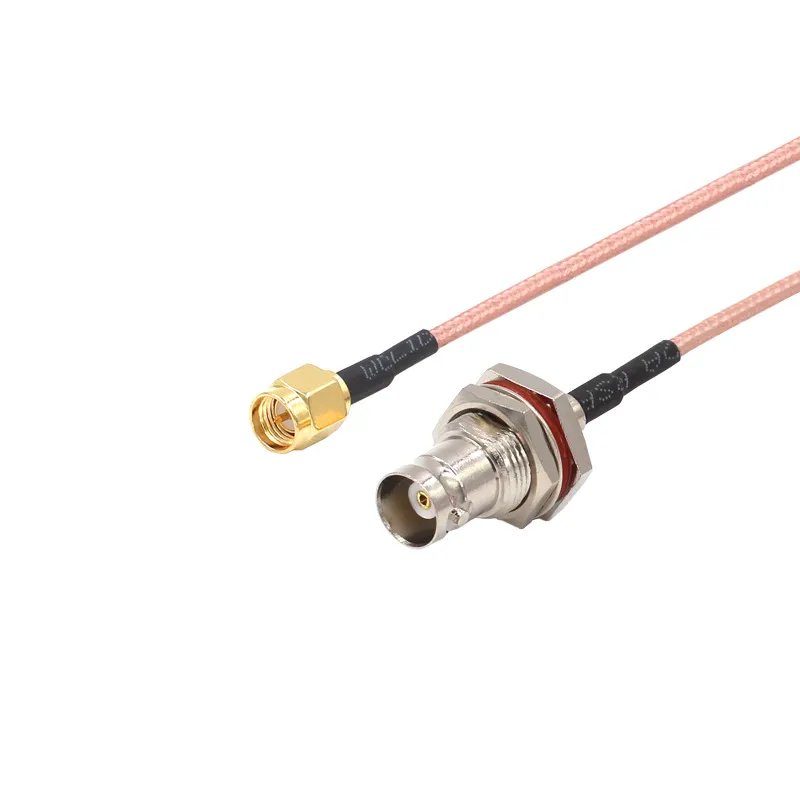
This image illustrates the critical installation step for outdoor deployments. It focuses on the bulkhead connector end of a waterproof extension cable. The image likely shows the threaded barrel of the connector inserted through a hole in an outdoor enclosure panel from the inside. The key detail is the silicone O-ring seated in its groove on the connector body. The image also shows the nut being tightened from the outside, compressing the O-ring against the panel surface to create a watertight and dust-tight IP67-rated seal. This visual guide is essential for ensuring long-term reliability in outdoor or automotive environments by preventing moisture ingress, which is emphasized as a critical failure point in the text.
The moment you take an antenna outdoors, weatherproofing becomes critical. Even a small leak can let in moisture, corrode the connector, and throw off your VSWR. That’s why choosing a waterproof antenna extension cable is more than just a nice-to-have—it’s the difference between a setup that lasts months and one that lasts years.
TEJTE’s assemblies include IP67-rated SMA bulkhead connectors with O-ring seals, designed for panel mount installations. This means you can route a cable through an enclosure wall while keeping a tight waterproof seal. For larger outdoor systems, N-type connectors with LMR240 are often preferred, since they handle long runs with less loss and offer stronger weather resistance.
Magnetic base options add another layer of flexibility. Installers often use them with RG174 or LMR200 for GSM or Wi-Fi setups on vehicles and rooftops. They allow antennas to be repositioned without drilling holes—a quick fix that’s surprisingly durable. Stock versions are available in 1.5 m, 3 m, and 5 m lengths, and TEJTE also supports custom builds when you need a very specific fit.
It’s not just Wi-Fi and 4G that benefit from proper sealing. Outdoor GPS units rely on a gps antenna cable to reach a clear sky view, and even a short run can fail if water gets in. For longer installations, a gps antenna extension cable with waterproof bulkhead and added weather tape ensures the signal stays stable. Seasoned installers often double up protection with self-amalgamating tape or weather caps—small details that pay off in long-term reliability.
Use-Case Playbook
Different wireless systems demand different kinds of antenna extension cables. Picking the right one is less about guessing and more about matching the application.
- Wi-Fi / Routers: Most consumer routers use RP-SMA ports. A rp-sma antenna extension cable in 3 m length lets you reposition antennas to avoid interference from walls or nearby electronics. It’s a small upgrade that often makes a big difference in coverage.
- IoT Gateways: Industrial devices and small modules usually rely on standard SMA ports. In these cases, an sma antenna extension cable with bulkhead mounting is a common choice, allowing the antenna to sit outside the cabinet while the hardware stays protected inside.
- 4G / 5G CPEs: Outdoor equipment needs longer runs. Installers often use LMR240 with N male to SMA female assemblies, bridging rooftop antennas to indoor modems without excessive loss.
- GPS Modules: Since GPS is highly sensitive to loss, short RG174 extensions (1–2 m) are used for in-car units, while low-loss LMR200 is preferred for outdoor relocations. A properly chosen gps antenna extension cable ensures the receiver maintains a strong satellite lock.
From Wi-Fi in a home office to 5G base stations or IoT gateways in industrial settings, the rule is simple: match the connector type, keep the run as short as practical, and select coax that fits the job. More detailed breakdowns can be found in TEJTE’s RF coaxial cable guide, which compares different setups across applications.
Compatibility & Pitfalls
Even a well-built antenna extension cable can cause problems if it’s the wrong type. The most frequent issue is connector mismatch. SMA and RP-SMA look nearly identical, but they will not mate. A quick check helps: an RP-SMA male has a socket in the center, while a standard SMA male has a pin. For routers, RP-SMA is the default; for GPS or IoT devices, SMA is almost always used. In many enclosures, an sma male to female extension cable is installed as a feed-through, but choosing the wrong polarity can make it useless.
Another pitfall is impedance. Most Wi-Fi, GPS, and cellular systems rely on 50 Ω coax such as RG174, LMR200, or LMR240. Accidentally mixing in a 75 Ω TV cable may seem harmless since the connectors screw on, but the mismatch causes reflections and weakens performance. It’s one of those silent issues that’s easy to miss until speeds or GPS accuracy drop.
Too many adapters are another trap. Every extra connector adds about 0.1–0.2 dB of insertion loss. One or two won’t ruin a setup, but stack three or four and you’ve effectively added a meter of RG174 to the run. On forums like Reddit and Amateur Radio Stack Exchange, many frustrated posts about “bad cables” really trace back to excessive couplers.
The solution is planning: confirm connector type, stick to 50 Ω coax, and order the correct length instead of patching with multiple small cables. A few minutes of checking upfront saves both money and performance later.
Buying Checklist
Before you add an antenna extension cable to the cart, it pays to run through a simple checklist. Skipping one of these steps is usually how the wrong cable ends up in your toolbox.
- Connector type & gender – Double-check whether your device needs SMA, RP-SMA, or N-type. Get the polarity right—mixing them up is a classic mistake.
- Cable specification – Match coax to distance. A short rg174 extension cable works fine for tight spaces and GPS modules. For 3–5 m runs, LMR200 is the sweet spot, while LMR240 handles 10 m outdoor LTE/5G lines with minimal loss.
- Length – Order only as long as you need, but don’t be afraid of a little extra if it helps antenna placement. TEJTE stocks common lengths like 1.5 m, 3 m, 5 m, and 10 m to cover typical installs.
- Outdoor sealing – For rooftop or field use, go with IP67-rated SMA or N-type assemblies. Adding a wrap of self-amalgamating tape or a weather cap can extend lifespan considerably.
- Panel mounting – If the cable will pass through an enclosure, check the bulkhead thread length against the panel thickness. A few millimeters off can cause headaches during installation.
- Accessories – A magnetic base extension is worth considering for mobile setups, while spare washers or waterproof caps save you from on-site improvisation.
- Quantity – Always order an extra cable. Installers know the rule: if you think you need two, bring three.
By following this checklist, you avoid the usual pitfalls and get a cable that fits your setup the first time. For deeper comparisons, TEJTE’s RF coaxial cable guide walks through how each coax type performs in real applications.
FAQ
Does an extension cable always reduce signal?
Yes. Every coax introduces attenuation, though the amount depends on type and length. A slim rg174 extension cable can lose 1.5–2.5 dB per meter, while LMR240 drops that to only ~0.25–0.4 dB/m. The key is whether the gain from better antenna placement outweighs the loss.
How long is too long for 2.4/5 GHz Wi-Fi?
At 2.4 GHz, a 3 m LMR200 build usually performs well. At 5 GHz, losses add up faster, so beyond 5 m you’ll want a low-loss option like LMR240. For routers, many users go with a rp sma extension cable in 1.5–3 m lengths, which balances flexibility and performance.
Is raising the antenna worth the extra loss?
Often, yes. Lifting the antenna even 2 m higher can add 6–10 dB in signal strength—easily offsetting the 1–2 dB lost in cable. It’s a trade-off many installers confirm on forums like Amateur Radio Stack Exchange.
Which connector is better outdoors, N-type or SMA?
N-type handles weather and torque better, which is why it’s standard for LTE and 5G outdoor antennas. Indoors, SMA or RP-SMA is usually fine. When bridging outdoor and indoor gear, an n male to sma female extension with LMR240 is a proven solution.
Can I waterproof a bulkhead feed-through easily?
Yes. An IP67 panel mount extension cable with O-ring seals is a solid start. Adding self-amalgamating tape or a weather cap makes the protection last much longer. TEJTE’s coaxial cable guide shows real-world sealing methods.
Do GPS antennas need special care with extensions?
They do. GPS signals are weak, so even small losses matter. A short gps antenna extension cable built with RG174 works for vehicles, but for longer outdoor runs, LMR200 is a safer bet to avoid losing satellite lock.
Final Thoughts
An antenna extension cable might look like a simple add-on, but it can make or break your wireless setup. The coax type matters—whether it’s a slim rg174 extension cable for short GPS or router jobs, a balanced LMR200 for 3–5 m Wi-Fi runs, or a low loss LMR240 for long LTE and 5G outdoor installations. Connector choice (SMA, RP-SMA, or N-type), sealing, and length planning all play into how well your system performs over time.
If you’re unsure what to choose, start with the basics: confirm your connector type, measure the length you truly need, and think about where the antenna will be placed. For Wi-Fi routers, a wifi antenna extension cable with RP-SMA often does the job. For GPS receivers, a carefully sized gps antenna extension cable can keep satellites locked. And for telecom gear, a 4g antenna extension cable in LMR240 with N-type connectors is often the most reliable solution.
Guides like TEJTE’s RF coaxial cable overview and SMA connector basics are good places to double-check the details before ordering. Careful planning up front saves frustration later.
Call to Action
Looking for reliable options? TEJTE offers a full range of sma antenna extension cables, rp-sma antenna extension cables, and n male to sma female extensions built with RG174, LMR200, and LMR240 coax. Stock lengths include 1.5 m, 3 m, 5 m, and 10 m, and there are IP67 waterproof bulkhead assemblies, panel mount builds, and magnetic base extensions available. For unique projects, custom lengths and connector variations are also supported.
Browse the TEJTE RF Coaxial Cable section or explore the TEJTE Blog for more installation tips and comparison guides. With the right extension cable, you’ll strike the perfect balance between antenna placement and signal performance.
Bonfon Office Building, Longgang District, Shenzhen City, Guangdong Province, China

A China-based OEM/ODM RF communications supplier
Table of Contents
Owning your OEM/ODM/Private Label for Electronic Devices andComponents is now easier than ever.
